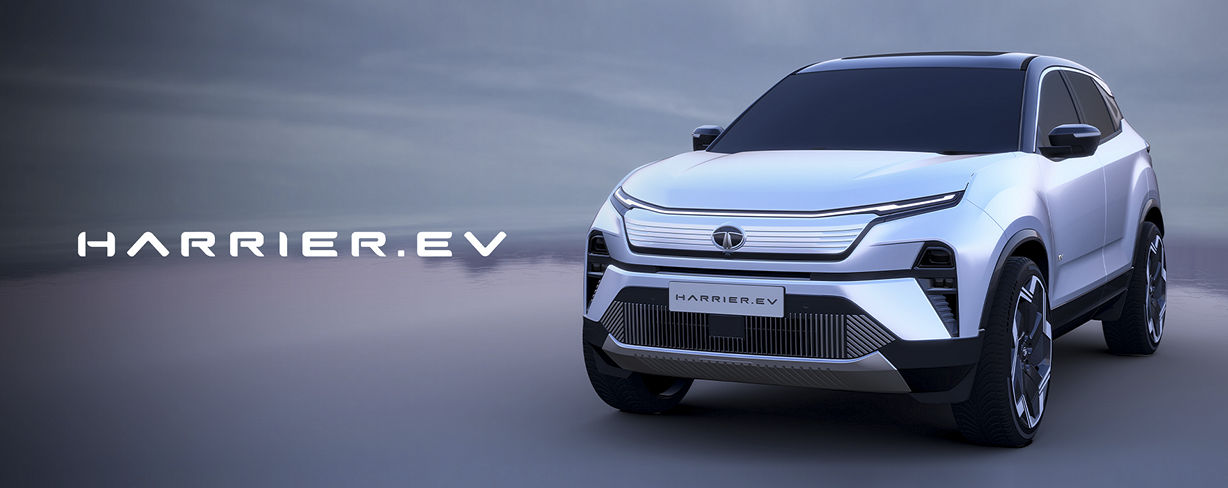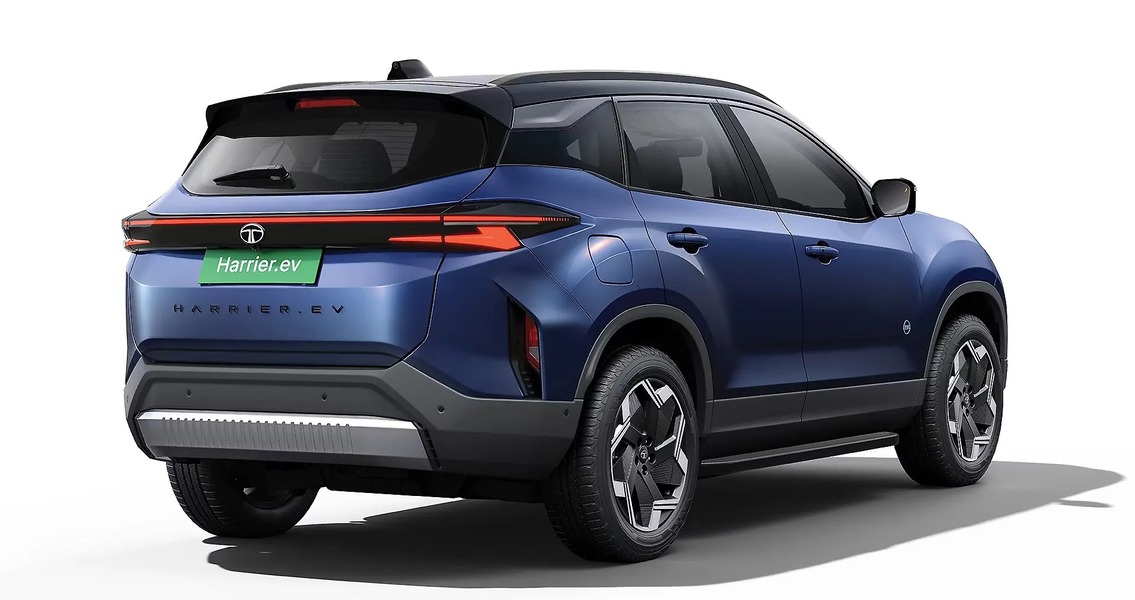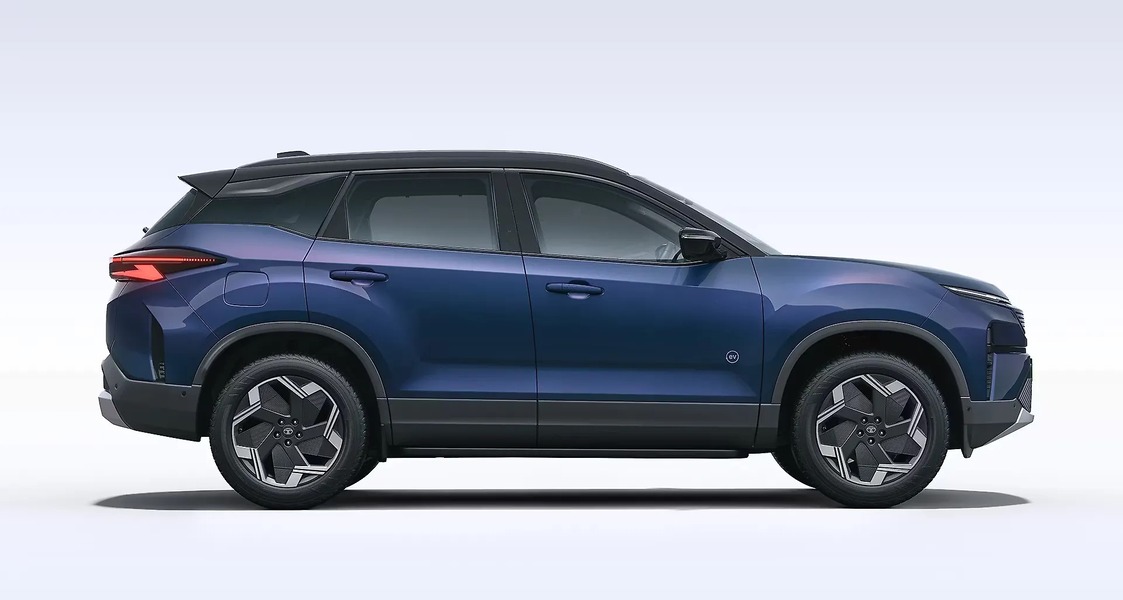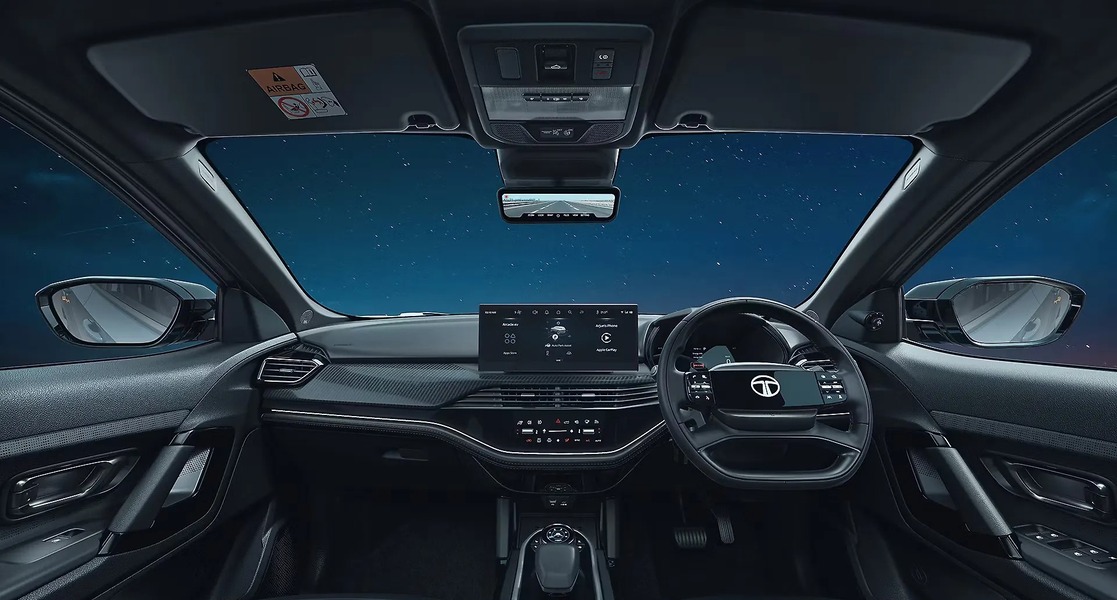HIGHLIGHTS
- Tata Harrier EV price in Nepal is expected to start between Rs. 65 Lakhs and Rs. 70 Lakhs.
- Harrier EV is Tata’s first electric all-wheel drive vehicle.
- It has shown a C75 range of 480 – 505 km, the highest in Tata’s electric lineup.
The Tata Harrier EV, which has already been launched in India, is expected to arrive in Nepal soon.

After its successful launch in India, the all-electric Tata Harrier EV is likely to make its way to Nepal soon, with Sipradi Trading—the official Tata distributor—spearheading its market entry.
The Harrier has always held a significant place in Tata’s lineup. Originally launched in 2019 as a diesel-powered mid-size SUV, it quickly gained popularity for its solid build quality, a signature trait of Tata vehicles.
Now, with the launch of the Harrier EV in India on June 3, 2025, Tata is clearly accelerating its push into the electric vehicle space. The Harrier EV marks a major step in that journey.
Tata has built it on the OMEGA architecture, which evolves from Land Rover’s acclaimed D8 platform. This platform has been re-engineered into Tata’s Gen 2 EV architecture to meet the demands of electric mobility.
What is the Price of Tata Harrier EV in Nepal?
Tata Harrier EV price in Nepal can be expected to start between Rs. 65 Lakhs to Rs. 70 Lakhs. Since, it is just recently launched in India, the official price in Nepal is a mystery.
Moreover, it has been introduced in both rear wheel drive and all wheel drive variants and both will probably make its way in Nepal. To add a context to the pricing, the price for the RWD variant is set at INRs. 21.49 Lakhs, in the Indian market while the price for other trims are yet to be released.
Nepal will likely get the Harrier EV by 2025, as Tata Nepal will try to carry the momentum setup by the preceding launch of Curvv.ev.
Stay tuned for any further updates!
With that said, let’s have a look at the key specifications of Tata Harrier EV in Nepal for 2025.
Tata Harrier EV Specifications
- Motor:
- 175 kW PMS Motor – RWD
- 175 kW / 115 kW PMS Motor – AWD
- Dimension: 4607 x 2132 x 1740 mm
- Wheelbase: 2741 mm
- Max Power:
- 238 PS – RWD
- 317 PS – AWD
- Max Torque:
- N/A – RWD
- 540 Nm – AWD
- Transmission: Automatic
- Drive Type:
- RWD
- AWD
- Top Speed: N/A
- Battery Type: Lithium Iron Phosphate (LFP)
- Battery Capacity:
- 65 kWh – RWD only option
- 75 kWh – RWD & AWD options
- Range:
- N/A – 65 kWh Battery RWD variant
- 627 km (MIDC) / 480 – 505 km (C75) – 75 kWh Battery RWD variant
- 622 km (MIDC) – 75 kWh Battery AWD variant
- Charging Time:
- 0 to 100% in around 10 hours via 7.2 kW AC Charger – 65 kWh Battery variant
- 0 to 100% in around 11 hours and 30 minutes via 7.2 kW AC Charger – 75 kWh Battery variant
- Tyres: 245/55 R19
- Tubeless Tyres: Yes
- Safety System: Multiple Airbags, 360 Degree Cam with Transparent Chassis, ESP, ADAS, Hill Assist
- Suspension Setup: McPherson Strut and Multi-link suspension
- Seating: 5-Seater
- Storage Space: 67-liter Frunk / 502-liter Boot space
- Ground Clearance: 205 mm
- Kerb Weight: 1900 – 2000 kg (Approx)
- Colors: Nainital Nocturne, Pure Grey, Pristine White, and Empowered Oxide
Tata Harrier EV Price in Nepal: TBA [Expected: Rs. 65 Lakhs – Rs. 70 Lakhs]
ALSO READ: Tata Cars Price in Nepal (December 2025 Updated)
Tata Harrier EV Overview
Design
The Tata Harrier EV retains much of its design DNA from the ICE Harrier while integrating modern EV-specific styling elements.
At the front, it features a sleek, blanked-off grille complemented by a redesigned bumper that houses vertical chrome slats, an element now familiar across Tata’s acti.ev-based models such as the Punch EV, Nexon.ev, and Curvv.ev.
Enhancing its appeal, the front lighting setup includes full-width LED DRLs and vertically stacked LED Bi-Projector Headlights.

Along the sides, the Harrier EV rides on 19-inch turbine-blade like Alloy Wheels designed for improved aerodynamics. The blacked-out window line, paired with the body color, gives the SUV a striking dual-tone finish.
The roofline gently slopes towards the rear to hint at a coupe-like silhouette, though the prominent C-pillar maintains the SUV’s bold stance. Tata’s signature high ground clearance also remains evident, ensuring the Harrier EV continues to offer robust road presence and practicality, which is its actual heritage.
At the rear, the design remains cohesive with a full-width connected LED Tail Lamp and a skid plate that mirrors the front bumper’s vertical slat pattern. A Powered Tailgate adds convenience and includes gesture control functionality for hands-free operation.
ALSO READ: Mahindra BE 6 Price in Nepal (December 2025 Updated)
Inside the cabin, the Harrier EV largely mirrors its ICE counterpart but introduces subtle EV-centric enhancements. The interior is wrapped in leatherette upholstery with a refined Dual-Tone Color scheme. Both front seats come with Power Adjustment, Ventilation, and Heating functions, while the rear seats include “Boss Mode” for rear passenger comfort.
The dashboard features a large 14.5-inch QLED Touchscreen Infotainment System sourced from Samsung, paired with a 10.25-inch Digital Instrument Cluster. This setup, now common across Tata’s new EVs, offers a clean, user-friendly interface. However, the glossy finish on the centered steering wheel may be prone to scratches over time.
Additional features include a Cooled Glove Box, fast-charging USB ports at the front and rear, a Wireless Phone Charger, Dual Zone AC, a Panoramic Sunroof, a Digital IRVM, and a premium 10-speaker JBL Sound System.

Additionally, the Harrier EV is available in a choice of sophisticated four color options: Nainital Nocturne, Pure Grey, Pristine White, and Empowered Oxide.
Performance
The Harrier EV will come in two battery pack options: a 65 kWh and a 75 kWh variant. The electric SUV offers two distinct powertrain layouts, featuring both Rear-Wheel Drive (RWD) and All-Wheel Drive (AWD) configurations. Impressively, the Harrier EV will become the first AWD electric vehicle from an Indian automotive manufacturer.
While Tata has yet to disclose complete performance details for each variant, some key specifications are already available. The 65 kWh variant will come equipped with a 175 kW Permanent Magnet Synchronous Motor that delivers a max power of 238 PS. However, Tata has not yet revealed the official torque and driving range figures for this version.
In contrast, the 75 kWh variant will be available in both RWD and AWD versions. The RWD model uses the same 175 kW motor as the smaller battery variant. Under the C75 test cycle, this model offers a certified range of 480 km to 505 km, while the MIDC test claims an optimistic range of 627 km.
And, the AWD variant with the 75 kWh battery pack features a Dual-Motor setup. It retains the 175 kW motor at the rear and adds a 115 kW motor at the front, resulting in a combined output of 317 PS and an impressive 504 Nm of max torque. According to the MIDC test, the driving range figure stands at 622 km.

Charging the 65 kWh battery pack from 0 to 100 percent using a 7.2 kW AC charger takes approximately 10 hours.
In comparison, the larger 75 kWh battery pack requires around 11 hours and 30 minutes to reach a full charge using the same charger.
Beyond its powertrain options, the Harrier EV offers advanced driving dynamics with six terrain modes: Normal, Snow/Grass, Mud-Ruts, Sand, Rock Crawl, and Custom. Moreover, there are four levels of regenerative braking and a dedicated Drift mode.
The Harrier EV clearly showcases its off-road capabilities, but its on-road performance is equally impressive. The All-Wheel-Drive variant sprints from 0 to 100 km/h in just 6.3 seconds, delivering strong acceleration right from the start.
Additional Details
McPherson Strut and Multi-link suspension with Frequency-Dependent Damper setup handles the suspension duties.
The dimensions are 4607 mm in length, 2132 mm in width, and 1740 mm in height. And, the wheelbase is 2741 mm.
Ground clearance of Harrier EV is approximately 205 mm. And, the kerb weight is estimated to be somewhere between 1900 kg – 2000 kg.
The boot space is 502-liter along with a 67-liter of frunk space.
Features
Here’s a list of key features available in the Tata Harrier EV in Nepal for 2025.

Tata Harrier EV Features Highlight
- Rear-Wheel and All-Wheel Drive Options
- 6 Terrain Modes
- Bi-Projector LED Headlamps
- Smart DRLs with Sequential Side Indicators
- Frunk Storage (67-liter)
- 19-inch Alloy Wheels
- Voice Assisted Panoramic Sunroof
- 205 mm Ground Clearance
- Powered Tailgate with Gesture Control
- 6-way Powered Driver Seat and 4-Way Powered Co-Driver Seat
- Boss Mode
- 14.5-inch QLED Touchscreen Infotainment System
- 10.25-inch Digital Instrument Cluster
- Digital IRVM
- Dual Zone AC
- 10-Speakers JBL Audio System
- ADAS
- Summon Mode and Auto Park Assist
- 6 Airbags
- 360 Degree Camera with Transparent Mode
- Electronic Stability Program
- Hill Assist
- Vehicle-To-Load (V2L)
- Vehicle-To-Vehicle (V2V)
ALSO READ: XPeng G6 Price in Nepal (December 2025 Updated)
Tata Harrier EV Price in Nepal and Availability
Tata Harrier EV price in Nepal is anticipated to start between Rs. 65 Lakhs to Rs. 70 Lakhs.
While the vehicle was showcased and launched in June 03, 2025 in India, the official bookings will only commence there from July 02, 2025.
So, it will take some time to come to Nepal as well. However, Nepal will likely get the Harrier EV by 2025.
Eventually more information on the specs, pricing, and variants are bound to be released so stay tuned for any further updates.
| Tata Harrier EV | Price in Nepal | Expected Price in Nepal |
|---|---|---|
| Tata Harrier EV | TBA | Starting at Rs. 6500000 – Rs. 7000000 |
Rivals
The Tata Harrier EV is set to rival the Mahindra XEV 9e in a head-to-head battle between two new-generation electric SUVs. Both models reflect the growing maturity of electric vehicle development within their respective companies. Tata and Mahindra have invested years into EV research and development, and the results are finally taking shape in the form of these promising products.
When it comes to performance, the Harrier EV holds a clear advantage with its All-Wheel-Drive capability, which is something the XEV 9e lacks entirely. This, combined with six dedicated terrain modes, makes the Harrier EV more suitable for light off-roading and adventurous drives.
On the technology front, the Harrier EV boasts a larger and more responsive 14.5-inch Infotainment Screen with a Samsung QLED panel. In comparison, the XEV 9e comes with a slightly smaller 12.3-inch unit, but makes up for it with a triple-screen layout that offers a detailed and highly informative driving interface. While Tata focuses on visual quality, Mahindra emphasizes practicality and driver-oriented design.
The Harrier EV also includes several modern conveniences such as a Digital IRVM that streams live footage from the rear camera, a Summon Mode for tight-space maneuvering, and a Transparent Mode that visually eliminates the car from the camera feed for a better view of the surroundings.
Given these features, along with its established Harrier legacy, the Harrier EV currently appears to be the more attractive option. However, the Mahindra XEV 9e deserves recognition for its bold, futuristic design and the extensive effort Mahindra put into building it from scratch. Unlike Tata, which could leverage the existing Harrier platform, Mahindra designed the XEV 9e entirely from the ground up, which is a remarkable achievement in itself.
Although both vehicles are expected to launch with similar starting prices in India, complete pricing and specification details for the Harrier EV are still forthcoming. As such, it’s too early to deliver a final judgment. Nonetheless, a compelling rivalry between these two flagship EVs is on the horizon, and it will be exciting to see how things unfold as more information becomes available.
Tell us what you think about the Tata Harrier EV. Did it arrive too late, or will it dominate the midsize electric‑SUV segment? Share your opinion in the comments below.
-
2025 Royal Enfield Hunter 350 Launched in Nepal: LED Headlamp, Slipper Clutch & Dual ABSHIGHLIGHTS The Royal Enfield Hunter 350 price in Nepal ranges from Rs. 4.95 Lakhs to…
-
Enco Buds3 Pro Launches in Nepal: Cheapest TWS from OPPOHIGHLIGHTS OPPO Enco Buds3 Pro price in Nepal is Rs. 3,499. The earbuds feature a…
-
MacBook Pro M5 14-inch Lands in Nepal at Rs. 2.79 Lakh: Worth the Wait?HIGHLIGHTS Apple MacBook Pro 14 M5 price in Nepal starts at Rs. 2,79,500. The design…














